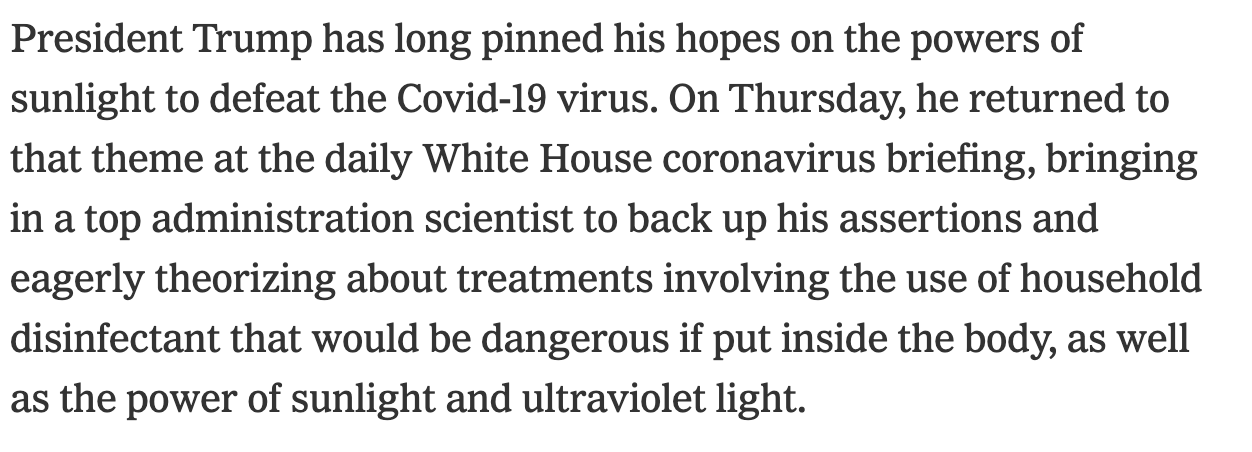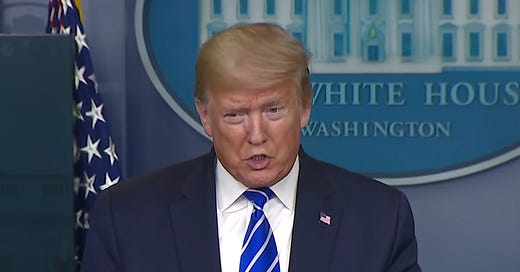

When they write the history of how America’s elite media handled the Donald Trump presidency, I suspect that this tweet from the New York Times will feature prominently:

The tweet and its accompanying story refer to the instantly infamous moment on Thursday when Trump began musing aloud about whether COVID-19 can be combated with ultraviolet light and an “injection” of disinfectant in the body. Here is some of what he said:
And then I see the disinfectant where it knocks it out in a minute — one minute — and is there a way we can do something like that by injection inside, or almost a cleaning? Because you see it gets in the lungs and it does a tremendous number on the lungs, so it would be interesting to check that.
You will surely have noticed that this is the kind of stuff that would get a normal person bundled off to an institution if they started screaming about it in a public setting. It does not take a Nobel Prize to understand that Trump is spewing dangerous nonsense. “Uhhhhhh the president is very wrong when he says to inject bleach in people” is not a tricky one in the annals of holding power to account. But the first instinct of the Times, the most important news outlet in America, was to cringe away from what should, by all rights, be a very easy task in both its tweet and its initial story:
“Dangerously, in the view of some experts.” Seven words that encompass an entire moldering journalistic ecosystem, a whole worldview that insists on retroactively transforming every monstrous, crackpot thing people in power say into just another point on the spectrum of American political thought.
It’s the “some” that really does it. “Some” implies that there are experts out there who back Trump up, that there is a live, reasoned debate to be had about whether a Lysol shot straight into your bloodstream is really the best way to ward off the coronavirus. Does the Times know something we don’t about the scientific dialogue around this topic? Did nobody realize that it’s quite irresponsible to suggest that only “some” people think a bleach injection is a bad idea—especially when Trump’s previous baseless medical assertions, such as his hyping of hydroxychloroquine, have had such serious consequences? (In an instance of grim timing, the FDA issued a warning against the use of hydroxychloroquine to treat COVID-19 on Friday morning). The Times has been doing lots of stellar work covering the coronavirus pandemic from multiple angles; we are right to expect more from them.
The paper eventually removed the offending phrase from later editions of the article. But its replacement was, if anything, even woolier and more confusing:
“Could” be harmful! Yes, I think it could!
As of 9:45 EST on Friday morning, here is how the first paragraph of the Times story looks.

“Could” has been helpfully replaced by “would,” but even this somewhat more assertive version beggars belief, with the crucial words buried under layers of verbiage and subclauses. What is so difficult about saying, “President Trump pushed the dangerous and false idea on Thursday that an injection of disinfectant into the body could be used to combat the COVID-19 virus”? Instead, the paper of record ducks and covers.
In a moment of pure, white-hot crisis, when the president of the United States is putting more people in harm’s way than ever before, some experts might call that kind of behavior dangerous too.
Screenshot: White House
















Fuck Dean Baquet with Maggie Habberman's dad.